Papers by Andreas Kyrozis

PubMed, Jun 1, 2023
This study aimed to review shoulder clinical and imaging findings in Parkinson's disease (PD), fo... more This study aimed to review shoulder clinical and imaging findings in Parkinson's disease (PD), focusing on the significance of timely diagnosis and management of shoulder dysfunction in PD for the prevention of shoulder-related complications. A bibliographical search was employed, using "Parkinson's" and "Shoulder Dysfunction" as keywords. A Magnetic Resonance Imaging, twenty clinical and three US studies were selected as relevant to shoulder dysfunction in PD. Shoulder pain, frozen shoulder and arm swing asymmetry are the most prevalent clinical findings that may antedate cardinal PD symptoms. Supraspinatus tendon thickening or tearing, adhesive capsulitis, acromioclavicular changes, bursa and joint effusion are common shoulder MRI or US-detected abnormalities in mild or severe PD stages. Fractures due to falls or osteoporosis are secondary shoulder pathologies. Higher ipsilateral Unified Parkinson's Disease Rated Scale (UPDRS) scores, rigidity, tremor, and bradykinesia are associated with frozen shoulder. Disease duration, rigidity, and falls are contributing factors for tendon tears, adhesive capsulitis, and fractures respectively. When common symptoms, such as pain and frozen shoulder are unaccounted for by orthopedic or other local primary pathology, they might indicate underlying early PD. Timely diagnosis and appropriate early management of PD may, in turn, help delay or prevent shoulder-related complications.
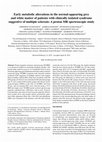
Experimental and Therapeutic Medicine, May 30, 2023
Proton magnetic resonance spectroscopy (1 H-MRS) is an advanced method of examining metabolic pro... more Proton magnetic resonance spectroscopy (1 H-MRS) is an advanced method of examining metabolic profiles. The present study aimed to assess in vivo metabolite levels in areas of normal-appearing grey (thalamus) and white matter (centrum semiovale) using 1 H-MRS in patients with clinically isolated syndrome (CIS) suggestive of multiple sclerosis and compare them to healthy controls (HCs). Data from 35 patients with CIS (CIS group), of which 23 were untreated (CIS-untreated group) and 12 were treated (CIS-treated group) with disease-modifying-therapies (DMTs) at the time of 1 H-MRS, and from 28 age-and sex-matched HCs were collected using a 3.0 T MRI and single-voxel 1 H-MRS (point resolved spectroscopy sequence; repetition time, 2,000 msec; time to echo, 35 msec). Concentrations and ratios of total N-acetyl aspartate (tNAA), total creatine (tCr), total choline (tCho), myoinositol, glutamate (Glu), glutamine (Gln), Glu + Gln (Glx) and glutathione (Glth) were estimated in the thalamic-voxel (th) and centrum semiovale-voxel (cs). For the CIS group, the median duration from the first clinical attack to 1 H-MRS was 102 days (interquartile range, 89.5.-131.5). Compared with HCs, significantly lower Glx(cs) (P=0.014) and ratios of tCho/tCr(th) (P=0.026), Glu/tCr(cs) (P= 0.040), Glx/tCr(cs) (P= 0.004), Glx/tNAA(th) (P= 0.043) and Glx/tNAA(cs) (P= 0.015) were observed in the CIS group. No differences in tNAA levels were observed between the CIS and the HC groups; however, tNAA(cs) was higher in the CIS-treated than in the CIS-untreated group (P= 0.028). Compared with those in HC group, decreased Glu(cs) (P=0.019) and Glx(cs) levels (P=0.014) and lower ratios for tCho/tCr(th) (P=0.015), Gln/tCr(th) (P=0.004), Glu/tCr(cs) (P= 0.021), Glx/tCr(th) (P= 0.041), Glx/tCr(cs) (P= 0.003), Glx/tNAA(th) (P= 0.030) and Glx/tNAA(cs) (P= 0.015) were found in the CIS-untreated group. The present findings showed alterations in the normal-appearing grey and white matter of patients with CIS; moreover, the present results suggested an early indirect treatment effect of DMTs on the brain metabolic profile of these patients.
Perspective on This Article from Anthropometric Measures, Physical Activity, and Risk of Glioma a... more Perspective on This Article from Anthropometric Measures, Physical Activity, and Risk of Glioma and Meningioma in a Large Prospective Cohort Study
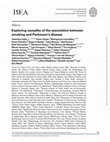
International Journal of Epidemiology, Nov 20, 2018
Background: The aim of this paper is to investigate the causality of the inverse association betw... more Background: The aim of this paper is to investigate the causality of the inverse association between cigarette smoking and Parkinson's disease (PD). The main suggested alternatives include a delaying effect of smoking, reverse causality or an unmeasured confounding related to a low-risk-taking personality trait. Methods: A total of 715 incident PD cases were ascertained in a cohort of 220 494 individuals from NeuroEPIC4PD, a prospective European population-based cohort study including 13 centres in eight countries. Smoking habits were recorded at recruitment. We analysed smoking status, duration, and intensity and exposure to passive smoking in relation to PD onset. Results: Former smokers had a 20% decreased risk and current smokers a halved risk of developing PD compared with never smokers. Strong dose-response relationships with smoking intensity and duration were found. Hazard ratios (HRs) for smoking <20 years were 0.84 [95% confidence interval (CI) 0.67-1.07], 20-29 years 0.73 (95% CI 0.56-0.96) and >30 years 0.54 (95% CI 0.43-0.36) compared with never smokers. The proportional hazard assumption was verified, showing no change of risk over time, arguing against a delaying effect. Reverse causality was disproved by the consistency of dose-response relationships among former and current smokers. The inverse association between passive smoking and PD, HR 0.70 (95% CI 0.49-0.99) ruled out the effect of unmeasured confounding. Conclusions: These results are highly suggestive of a true causal link between smoking and PD, although it is not clear which is the chemical compound in cigarette smoking responsible for the biological effect.
Dementia and Geriatric Cognitive Disorders, 2017
Aim: To examine the association between a healthy diet, assessed by the Healthy Diet Indicator (H... more Aim: To examine the association between a healthy diet, assessed by the Healthy Diet Indicator (HDI), and cognitive decline in older adults. Methods: Data from 21,837 participants aged ≥ 55 years from 3 cohorts (Survey in Europe on Nutrition and the Elderly, a Concerted Action
Perspective on This Article from Anthropometric Measures, Physical Activity, and Risk of Glioma a... more Perspective on This Article from Anthropometric Measures, Physical Activity, and Risk of Glioma and Meningioma in a Large Prospective Cohort Study
Clinical Neurophysiology, Mar 1, 2019
of high-resolution ultrasound in screening for carpal tunnel syndrome and grading its severity is... more of high-resolution ultrasound in screening for carpal tunnel syndrome and grading its severity is moderated by age,

Background: Preoperative anxiety is common and can have deleterious effects, such as fluctuations... more Background: Preoperative anxiety is common and can have deleterious effects, such as fluctuations in blood pressure, heart and respiratory rate, resistance to anesthetic induction, higher levels of postoperative pain and poor healing. Our aim was to assess the reliability and validity of the Greek version of the Amsterdam Preoperative Anxiety and Information Scale (APAIS). Methods: One hundred patients completed a modified (Greek) APAIS questionnaire and the Spielberger’s State-Trait Anxiety Inventory (STAI-State) during routine preoperative screening from March to May 2015. Both general and regional anesthesia patients were included and various clinical data, such as age, sex, level of education, marital status, American Society of Anesthesiologists (ASA) physical status classification system and previous surgery were collected. Findings: Exploratory factor analysis revealed a new two factors model of the Greek version of APAIS: anxiety and need for information related to anesthesi...
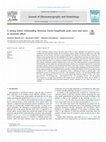
Journal of electromyography and kinesiology : official journal of the International Society of Electrophysiological Kinesiology, 2018
In EMG interference pattern analysis, the peak value of turns to mean amplitude ratio [peak(T/A)]... more In EMG interference pattern analysis, the peak value of turns to mean amplitude ratio [peak(T/A)] is an established clinically significant marker, but its calculation requires specific software available only in few EMG apparatuses. On the contrary, the turns to mean amplitude ratio obtained at maximal muscle contraction (T/Amax) is easily calculated but less well standardized. We aimed to quantitatively assess the association between T/Amax and peak(T/A). Data were derived from 642 muscle contractions (Nc) from 270 consecutive patients (Np) who underwent EMG at our laboratory (software Dantec Keypoint, QEMG) from May 2015 to September 2016 and had interference patterns obtained from at least one of the following muscles: triceps-lateral head, brachioradialis, extensor digitorum communis and biceps. Statistics were calculated separately for normal and neurogenic muscles. Peak(T/A) was calculated by the built-in "peak ratio" function. T/Amax was calculated by the built-in I...

Psychogeriatrics : the official journal of the Japanese Psychogeriatric Society, Jan 2, 2018
The aim of this study was to assess the ability of Neuropsychiatric Inventory (NPI) scale profile... more The aim of this study was to assess the ability of Neuropsychiatric Inventory (NPI) scale profiles to differentiate between distinct frontotemporal dementia (FTD) subtypes. The NPI was used to assess 311 older patients who had been clinically diagnosed with FTD. FTD subtypes included behavioural variant FTD (bvFTD, n = 121), primary progressive aphasia (semantic variant (n = 69), non-fluent agrammatic variant (n = 31), and logopenic variant (n = 0)), FTD-motor neuron disease (n = 4), progressive supranuclear palsy (n = 43), and corticobasal syndrome (n = 43). Total NPI score and scores for each NPI item were correlated across the distinct FTD subtypes. Patients with bvFTD showed significantly greater impairment on their total NPI score than patients with corticobasal syndrome (P < 0.001), non-fluent agrammatic variant primary progressive aphasia (P < 0.001), progressive supranuclear palsy (P = 0.002), and semantic variant primary progressive aphasia (P = 0.010). Aggressiveness...
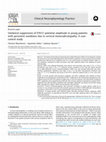
Clinical Neurophysiology Practice, 2017
Objective: The utility of Dermatomal Somatosensory Evoked Potentials (DSEPs) in the diagnostic wo... more Objective: The utility of Dermatomal Somatosensory Evoked Potentials (DSEPs) in the diagnostic workup of suspected cervical monoradiculopathy has been limited by significant overlap between measurements obtained from affected versus unaffected roots. In a case-control study, we explored whether, under certain conditions, asymmetry in DSEP parameters may offer significant help in the diagnosis of monoradiculopathy. Methods: DSEPs were obtained bilaterally from patients with persistent (age range 33-55, n = 10) or intermittent (age range 31-55, n = 7) unilateral sensory symptoms of less than one month duration due to MRI-confirmed cervical monoradiculopathy. DSEPs were also obtained bilaterally from agedmatched asymptomatic volunteers (age range 31-54, n = 8) and older asymptomatic volunteers (age range 57-77, n = 8). Amplitude and latency of the P/N13 0 potential (negative peak at 13 ms) were measured. Results: In all ten patients with persistent symptoms, the P/N13 0 amplitude ratio, defined as P/N13 0 amplitude on the symptomatic side divided by P/N13 0 amplitude on the contralateral asymptomatic side, ranged between 0.0 and 0.50 (unilateral suppression). In all seven patients with intermittent symptoms, P/N13 0 amplitude ratios ranged between 0.60 and 1.00. In all age-matched asymptomatic controls, P/N13 0 amplitude ratio (side with lower divided by side with higher amplitude) was always at least 0.80. Among older asymptomatic subjects, DSEPs had inconsistent characteristics. Conclusions: Cervical monoradiculopathy with persistent numbness in young patients (aged up to 55 years) is very strongly associated with unilateral suppression of P/N13 0 DSEP amplitude. No significant asymmetry is observed in cases of monoradiculopathy with intermittent numbness. Significance: In young patients with unilateral upper extremity persistent sensory complaints, DSEP amplitude asymmetry, as quantified by the P/N13 0 ratio, may offer significant help in the diagnosis of monoradiculopathy.
Alzheimer's & Dementia, 2011
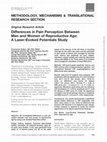
Pain Medicine, 2016
Objective. We investigated differences in pain perception between men and women of reproductive a... more Objective. We investigated differences in pain perception between men and women of reproductive age by using Laser-Evoked Potentials (LEPs). Design, Setting, Subjects. Forty-four right-handed healthy volunteers (19 males/25 females), aged 30-40 years were studied. A CO 2 laser generated three series of 10 thermal pulses (4.5 W) on the radial aspect of the dorsum of the left hand. A recording montage for late LEPs was used, and the potentials of each series of stimuli were averaged to calculate mean latency and amplitude for each subject. Volunteers scored verbally pain intensity (Numerical rating scale [NRS]; 0-10). Three series of 10 numbers were averaged for calculation of mean NRS score. Methods. LEP peak-to-peak amplitude, latency, and NRS scoring were compared between genders, and correlations between LEP amplitude/latency and NRS scores were assessed. Results. Data from 44 subjects were analyzed. LEP amplitudes differed significantly (P < 0.001) between men (24.2 6 6.0 mV) and women (38.9 6 15.28 mV), while no difference was found for latency (156.5 6 8.6 versus 160.4 6 19.8 ms, P 5 0.42) or NRS score (2.6 6 1.5 versus 2.4 6 1.4, P 5 0.63), respectively. Menstrual cycle phase did not influence LEP parameters (P 5 0.59 for amplitude and P 5 0.69 for latency) or NRS score (P 5 0.95). No significant correlation was found between latency or amplitude and NRS score (P 5 0.43 and P 5 0.90, respectively). Conclusions. Our results demonstrate a significant gender-related difference in LEP amplitudes with lower mean values in men, while no difference was found in LEP latencies or in subjective pain ratings. Further research is required to clarify the clinical significance of the above experimental findings.
Behavioral Sleep Medicine
Background: The etiologies of glioma and meningioma tumors are largely unknown. Although reproduc-

<strong><em>Background/Aims:</em></strong> Large epidemiological prospect... more <strong><em>Background/Aims:</em></strong> Large epidemiological prospective studies represent an important opportunity for investigating risk factors for rare diseases such as Parkinson's disease (PD). Here we describe the procedures we used for ascertaining PD cases in the EPIC (European Prospective Investigation into Cancer and Nutrition) study. <b><i>Methods:</i></b> The following three-phase procedure was used: (1) elaboration of a NeuroEPIC4PD template for clinical data collection, (2) identification of all potential PD cases via record linkage and (3) validation of the diagnosis through clinical record revision, in a population of 220,494 subjects recruited in 7 European countries. All cases were labelled with the NeuroEPIC4PD diagnoses of 'definite', 'very likely', 'probable', or 'possible' PD. <b><i>Results:</i></b> A total of 881 PD cases were identified, with over 2,741,780 person-years of follow-up (199 definite, 275 very likely, 146 probable, and 261 possible). Of these, 734 were incident cases. The mean age at diagnosis was 67.9 years (SD 9.2) and 458 patients (52.0%) were men. Bradykinesia was the most frequent presenting motor sign (76.5%). Tremor-dominant and akinetic rigid forms of PD were the most common types of PD. A total of 289 patients (32.8%) were dead at the time of the last follow-up. <b><i>Conclusions:</i></b> This exercise proved that it is feasible to ascertain PD in large population-based cohort studies and offers a potential framework to be replicated in similar studies.

Journal of Electromyography and Kinesiology, 2021
The aim of the study was to test whether logistic curve fitting (LCF) of Turns = f(Amplitude) plo... more The aim of the study was to test whether logistic curve fitting (LCF) of Turns = f(Amplitude) plots of single muscle contractions can provide a reliable alternative method for peak-ratio calculation. EMG signals from 74 biceps and 62 triceps contractions were analyzed by applying LCF to Turns = f(Amplitude) plots. Peak-ratio (peak-ratio2) could then be calculated as the point of the fitted line with the highest Turn/Amplitude value. LCF yielded R2 values > 0.95 in the vast majority of contractions studied (68/74 biceps and 53/62 triceps). Peak-ratio2 values had a very strong linear relationship with the corresponding values calculated by the traditional method (peak-ratio1) in both normal and neurogenic conditions. Furthermore, ROC curve analysis showed that peak-ratio1 and peak-ratio2 had similar AUC values. Based on the LCF equation, peak-ratio = T2*(p - 1)/A0*p*(p - 1)1/p. Therefore, peak-ratio is proportional to the maximum number of turns (T2), positively correlated to the rate of turns' increment at the midpoint of the curve (p) and negatively correlated to the mean amplitude at the midpoint of the curve (A0). A0 is the variable that best discriminates between normal and neurogenic conditions. We provide an alternative method for peak-ratio calculation and show the variables that influence this sensitive marker of neurogenic disease.









Uploads
Papers by Andreas Kyrozis